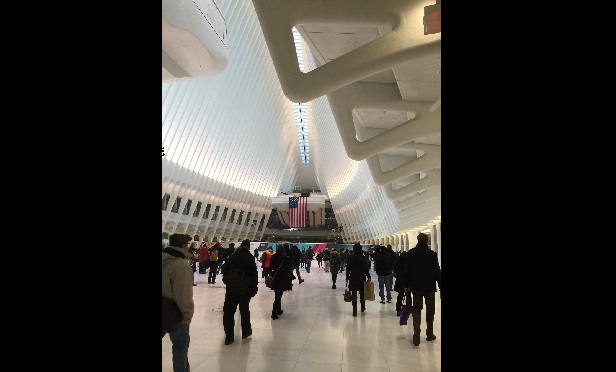
 The Oculus transportation hub, at the new New York World Trade Center. (Photo: Allison Bell/TA)
The Oculus transportation hub, at the new New York World Trade Center. (Photo: Allison Bell/TA)
The original version of this article ran Sept. 9, 2016.
For those who lived through major tragic events in the nation's history — Pearl Harbor, the death of President Franklin Roosevelt, John F. Kennedy's assassination — the first thought that often comes to mind is where they were as the events unfolded.
And so it was for Americans who bore witness to the seminal event of the past decade: the terrorist attacks of Sept. 11, 2001.
Among life insurance executives interviewed by LifeHealthPro in the run up to this 15th anniversary of the 9/11 attacks, the high drama of that day left deep and lasting marks, both personally and professionally.
The thousands of lives lost that clear September morning gave their life's work — protecting the uninsured and the underinsured — a renewed sense of purpose. Significantly, the war on terror following the attacks also prompted changes at the carriers, including an industry-wide reassessment of the insurers' ability to withstand subsequent, 9/11-like attacks.
The events that forced these developments — passenger jets that crashed into the World Trade Center's north and south towers and, later, the Pentagon and a field in Pennsylvania — halted all business at insurers around the country. After absorbing the initial shock, carrier executive set in motion urgent procedures to attend to their people, assets and, not least, their policyholders.
"We had TV monitors in all of our elevator banks and people were glued to them," says Patrick Foley, president of individual life and financial services at OneAmerica. "We immediately began checking on traveling employees to be sure they were okay. Because of the prospect of follow-up attacks, everyone was in a mad dash to get home."
But not in the air. Because the government had grounded planes after the attacks, insurance executives traveling on business were forced to make their way home by car, bus or rail — and sometimes with a bit of stealth.
Christopher Carlson, national vice chairman for strategic businesses at Ohio National, says that company execs then in New York City were "less than forthcoming" with an agent of car rental business about plans to drive a rental vehicle from NYC to the insurer's home offices in Cincinnati. The reason: travel restrictions the rental company had imposed on the use of its cars.
Such inconveniences aside, carrier execs say their employees and family members were fortunate in that none were in the vicinity of the twin towers during the attacks.
Though physically unscathed many, however, experienced anguish and anxiety in the days following, often after reconnecting with friends or business colleagues who were personally affected.
Responding to the tragedy
Carlson recalls a conversation with a New York City-based Merrill Lynch executive who saw employees jumping off one of the tower's top floors — and hurtling to their deaths more than a thousand feet below — to avoid being consumed by fires engulfing the building.
"I was struck by how he had been scarred for life watching these events," says Carlson. "Listening to personal stories like these … They always stay with you."
Executives also vividly remember events underway at their corporate offices: Call centers turned into veritable war rooms as agents and service representatives fielded calls from anxious customers. Many connected to inquire about the safety of their policies and plan assets. Other callers sought information about missing family members, friends or business associates.
That was the case at Minnesota Life, a Securian Financial unit that went on high alert after the attacks to brace for an influx of calls. The insurer designated one staffer to handle 9/11-related inquiries; others managed the inevitable death claims.
Gregg Hammerly, a second vice president of claims and 33-year veteran at Securian, says the insurer processed more than 30 claims and distributed over $5 million in death benefits to beneficiaries of 9/11 victims. Payouts were about evenly distributed across the company's book of business, including both individual and group life insurance policies. Claims also were made on products offered through Securian's Financial Institutions unit, including mortgage accidental death insurance, mortgage life insurance and mortgage disability insurance.
In total, says Hammerly, the policy tally jibed with Securian's estimate of death claims calculated in the wake of the attacks.
"At the end of the assessment, claims fell into the range of our projections," said Hammerly. "The estimates were spot-on."
That may have proved gratifying to top execs keeping an eye on the bottom line. But for customer service representatives processing claims, the personal interactions with policy beneficiaries brought their own rewards. Hammerly recalls staffers who received at Christmas time "thank you" cards from survivors of 9/11 victims.
"That they would take the time to reach out to us after everything they had been through was really touching," he says. "As a result of the attacks, we saw the worst of the world, but also had many positive experiences in the way people were handling the tragedy."
Planning for the next one
Within insurers' C-suites, the attacks also prompted reviews of their ability to financially withstand another catastrophe (man-made or otherwise) and make good on policy claims. The risk assessments were particularly critical for multiline insurers with exposure to losses not only through their life insurance book of business, but also property and casualty lines.
"Whenever you're doing long-term risk scenarios, you consider potential 'Black Swan' events," says OneAmerica's Foley. "But after 9/11, the financial consequences of natural or unnatural disaster became much more prominent in our long-term planning. These types of events were taken very seriously."



